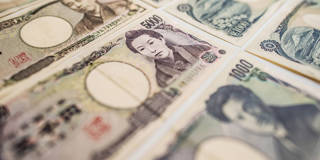Economists should not blame the Bank of Japan’s monetary policies for the yen’s declining purchasing power. It is flatlining productivity in tradable sectors and stagnant real wages that explain the arrival of Cheap Japan.
TOKYO – Every month, the Bank for International Settlements calculates and publishes the real and nominal effective exchange rates for major currencies. The most recent data, released in mid-February, contained a shock for Japan. They show that the yen’s real effective exchange rate (REER, representing roughly the purchasing power of the currency) is now as low as it was in the early 1970s, when the yen was first floated following the collapse of the Bretton Woods and Smithsonian systems of fixed exchange rates.
As the yen’s purchasing power has weakened, the Japanese have noticed that imported goods are now more expensive, and the media are full of stories about Japanese visitors to New York, London, and Singapore being surprised by the high prices of goods and services there. In Tokyo, for example, a bowl of ramen typically costs less than ¥1,000 ($8.66), but in New York, based on my observations, it costs more than $20. A McDonald’s Big Mac costs the equivalent of $3.38 in Tokyo, as opposed to $5.81 in the United States, according to The Economist.
Similar comparisons can be made for subway fares, Uniqlo Heattech undershirts, five-star hotel rooms, and many other goods and services. Prime property in Tokyo, which was the most expensive in the world 30 years ago, is now much cheaper than in any other major financial center.

TOKYO – Every month, the Bank for International Settlements calculates and publishes the real and nominal effective exchange rates for major currencies. The most recent data, released in mid-February, contained a shock for Japan. They show that the yen’s real effective exchange rate (REER, representing roughly the purchasing power of the currency) is now as low as it was in the early 1970s, when the yen was first floated following the collapse of the Bretton Woods and Smithsonian systems of fixed exchange rates.
As the yen’s purchasing power has weakened, the Japanese have noticed that imported goods are now more expensive, and the media are full of stories about Japanese visitors to New York, London, and Singapore being surprised by the high prices of goods and services there. In Tokyo, for example, a bowl of ramen typically costs less than ¥1,000 ($8.66), but in New York, based on my observations, it costs more than $20. A McDonald’s Big Mac costs the equivalent of $3.38 in Tokyo, as opposed to $5.81 in the United States, according to The Economist.
Similar comparisons can be made for subway fares, Uniqlo Heattech undershirts, five-star hotel rooms, and many other goods and services. Prime property in Tokyo, which was the most expensive in the world 30 years ago, is now much cheaper than in any other major financial center.